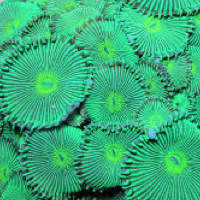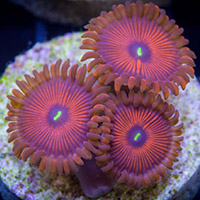Just posted up this video after getting poisoned by the Palytoxin.
Navigation
Install the app
How to install the app on iOS
Follow along with the video below to see how to install our site as a web app on your home screen.
Note: This feature may not be available in some browsers.
More options
You are using an out of date browser. It may not display this or other websites correctly.
You should upgrade or use an alternative browser.
You should upgrade or use an alternative browser.
Paly Eradication and Palytoxin Safety Tips
- Joined
- Feb 15, 2012
- Messages
- 4,699
- Reaction score
- 3,395
This is a great example of getting intoxicated by the so called "nuclear greens" that so many people think is palytoxin free!!!
The very best way to get rid of them is to use a very fine knife and scrape them side ways while you siphon them to a shark bag during water changes. A good activated carbon will remove palytoxin from the water in the long run.
The article below mistakenly published a "relief "about most zoanthids in the hobby and shouldn't be taken seriously!!! Actually they should remove that article from the source all together IMO.

 reefs.com
reefs.com

 reefs.com
Be very careful about reading things published online!
reefs.com
Be very careful about reading things published online!
Be safe and not sorry!!! Great video!!!
The very best way to get rid of them is to use a very fine knife and scrape them side ways while you siphon them to a shark bag during water changes. A good activated carbon will remove palytoxin from the water in the long run.
The article below mistakenly published a "relief "about most zoanthids in the hobby and shouldn't be taken seriously!!! Actually they should remove that article from the source all together IMO.

The Dangers (and Myths) of Zoa Toxicity – Part 1
The oceans are full of creatures capable of killing us; one of the more surprising marine menaces is a group of popular aquarium corals known variably as “but

The Dangers (and Myths) of Zoa Toxicity – Part 2
(Continued from Part 1) When it comes to toxic palys, it is the drab brown specimens that we see most often, but there may be at least some colorful phenotyp
Be safe and not sorry!!! Great video!!!
- Joined
- Feb 15, 2012
- Messages
- 4,699
- Reaction score
- 3,395
Below is my own quote from other post:
"It is imperative that we consider the facts as they are and to know there is a risk of toxicity in every zoanthid we can encounter in the hobby. Not only Palythoa spp., but also Zoanthus spp. The article posted previously and reposted above in this post doesn't tell us that it is 100% safe to handle all Zoanthus spp..
Zoanthus spp. COULD carry small amounts of palythoxin and the risk of harm by the toxin shouldn't be ignored. We should consider that an individual sensitive to palythoxin could die if a small amount (from a "weakly toxic" Zoanthus sansibaricus) make it's way to that individual.
IMHO Mr. Joe Rowlett made some crucial mistakes when writing his lines like:
"It is important to understand that palytoxin is not present in every species of “zoa”. I have heard many knowledgeable aquarists incorrectly state that all “zoanthids” contain it and are therefore dangerous, which is not accurate whatsoever. Such blanket statements show a lack of expertise in these corals and the extensive research recently published on them. One such study (Deeds et al 2011) focused on aquarium specimens and found that there is likely a single lineage of button polyps which is truly dangerous to the general aquarium community. This makes proper identification of the utmost importance, so lets jump into the esoterica of invertebrate taxonomy and attempt at last to correctly identify these deadly corals and their harmless relatives."
Sadly in the quote above alone we can see the mistakes in referring to the total lack of expertise when the author himself calls zoanthids "corals". He get's one isolated study to try to prove his claims on general safety of some zoanthids' species found in the hobby. So dangerously affirming that is likely "a single lineage of button polyps" to be "truly dangerous to the general aquarium community".
The whole article is not written in a scientific format, nor based in many important scientific papers, and should be read/interpreted with caution!

Let's keep that important fact in mind and avoid to spread a generalized message about this subject. Palythoxin is the second strongest toxin in the world. Lets be responsible and keep it safe, not sorry! We've already had way too many victims!
Peace!"
FROM: https://www.reef2reef.com/threads/w...an-aquarium-store-near-you.94354/post-6558948
"It is imperative that we consider the facts as they are and to know there is a risk of toxicity in every zoanthid we can encounter in the hobby. Not only Palythoa spp., but also Zoanthus spp. The article posted previously and reposted above in this post doesn't tell us that it is 100% safe to handle all Zoanthus spp..
Zoanthus spp. COULD carry small amounts of palythoxin and the risk of harm by the toxin shouldn't be ignored. We should consider that an individual sensitive to palythoxin could die if a small amount (from a "weakly toxic" Zoanthus sansibaricus) make it's way to that individual.
IMHO Mr. Joe Rowlett made some crucial mistakes when writing his lines like:
"It is important to understand that palytoxin is not present in every species of “zoa”. I have heard many knowledgeable aquarists incorrectly state that all “zoanthids” contain it and are therefore dangerous, which is not accurate whatsoever. Such blanket statements show a lack of expertise in these corals and the extensive research recently published on them. One such study (Deeds et al 2011) focused on aquarium specimens and found that there is likely a single lineage of button polyps which is truly dangerous to the general aquarium community. This makes proper identification of the utmost importance, so lets jump into the esoterica of invertebrate taxonomy and attempt at last to correctly identify these deadly corals and their harmless relatives."
Sadly in the quote above alone we can see the mistakes in referring to the total lack of expertise when the author himself calls zoanthids "corals". He get's one isolated study to try to prove his claims on general safety of some zoanthids' species found in the hobby. So dangerously affirming that is likely "a single lineage of button polyps" to be "truly dangerous to the general aquarium community".
The whole article is not written in a scientific format, nor based in many important scientific papers, and should be read/interpreted with caution!
Let's keep that important fact in mind and avoid to spread a generalized message about this subject. Palythoxin is the second strongest toxin in the world. Lets be responsible and keep it safe, not sorry! We've already had way too many victims!
Peace!"
FROM: https://www.reef2reef.com/threads/w...an-aquarium-store-near-you.94354/post-6558948
Thanks for your help on this post. You seem to be an expert in the field of palytoxins. I'm just a guy relating my story with the stuff. I do however believe that the toxins aerosolize into your home and can cause symptoms that are ongoing during the dry winter months. If you fiddle around with your tank every couple of days, and the Zoas or Palys release toxins into the water, and you go through 2 or more gallons of evaporation a week, the toxin is in the air in your home.
We felt sick and achy all the time for a couple of years with all those Palys in my tanks. We both are starting to feel better now that it's all gone. Why would anyone want to have those in their home? Get some flowers instead. Just sayin....
- Joined
- Feb 15, 2012
- Messages
- 4,699
- Reaction score
- 3,395
I'm not an expert in palytoxin, but I live in Hawaii and the only anthozoans we can keep legally here, with the proper permits, are zoanthids and some local soft corals. Therefore I have a zoanthid dominated system and have been collecting my own for more than 20 years. I can assure that while most of the Zoanthus spp. or Palythoa spp. COULD have very low toxicity, they MIGHT have significant effects on differnt individuals, depending on how those people would handle those organisms. The other side of the coin is that some of them CAN carry sky high doses of the toxin and be FATAL even for the non- sensitive individuals.Thanks for your help on this post. You seem to be an expert in the field of palytoxins. I'm just a guy relating my story with the stuff. I do however believe that the toxins aerosolize into your home and can cause symptoms that are ongoing during the dry winter months. If you fiddle around with your tank every couple of days, and the Zoas or Palys release toxins into the water, and you go through 2 or more gallons of evaporation a week, the toxin is in the air in your home.
We felt sick and achy all the time for a couple of years with all those Palys in my tanks. We both are starting to feel better now that it's all gone. Why would anyone want to have those in their home? Get some flowers instead. Just sayin....
The danger with palytoxin is more likely to be related to particular colonies than species' identification or colors, as many tend to preach.
Any system containing zoanthids is like a bomb to explode and needs constant attention and observation. Good example of that in that video I've posted by Julian Sprung.
While is safe to say that most zoanthids in the hobby are "fairly safe" to keep, we just can't affirm and find those to buy.
I know so many people, including very experienced divers, that could be dead after passing over zoanthid's colonies in the wild. That is serious stuff!!!
Thanks again for that video.
Here is my system:
I believe i was poisoned by dinoflagellets. My symptoms were bad. Muslce Aching and tiredness. It got to the point where i couldnt stand up one day. Doctors couldnt find nothing except slightly low calcium and iron. Pretty sure it was the dinos.















